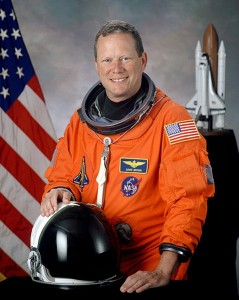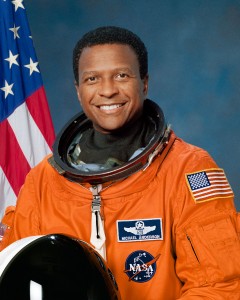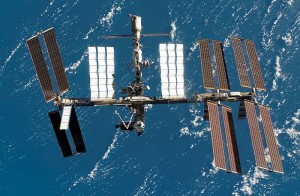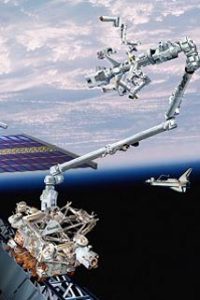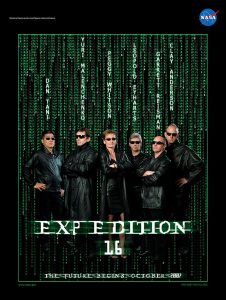STS-107 Columbia
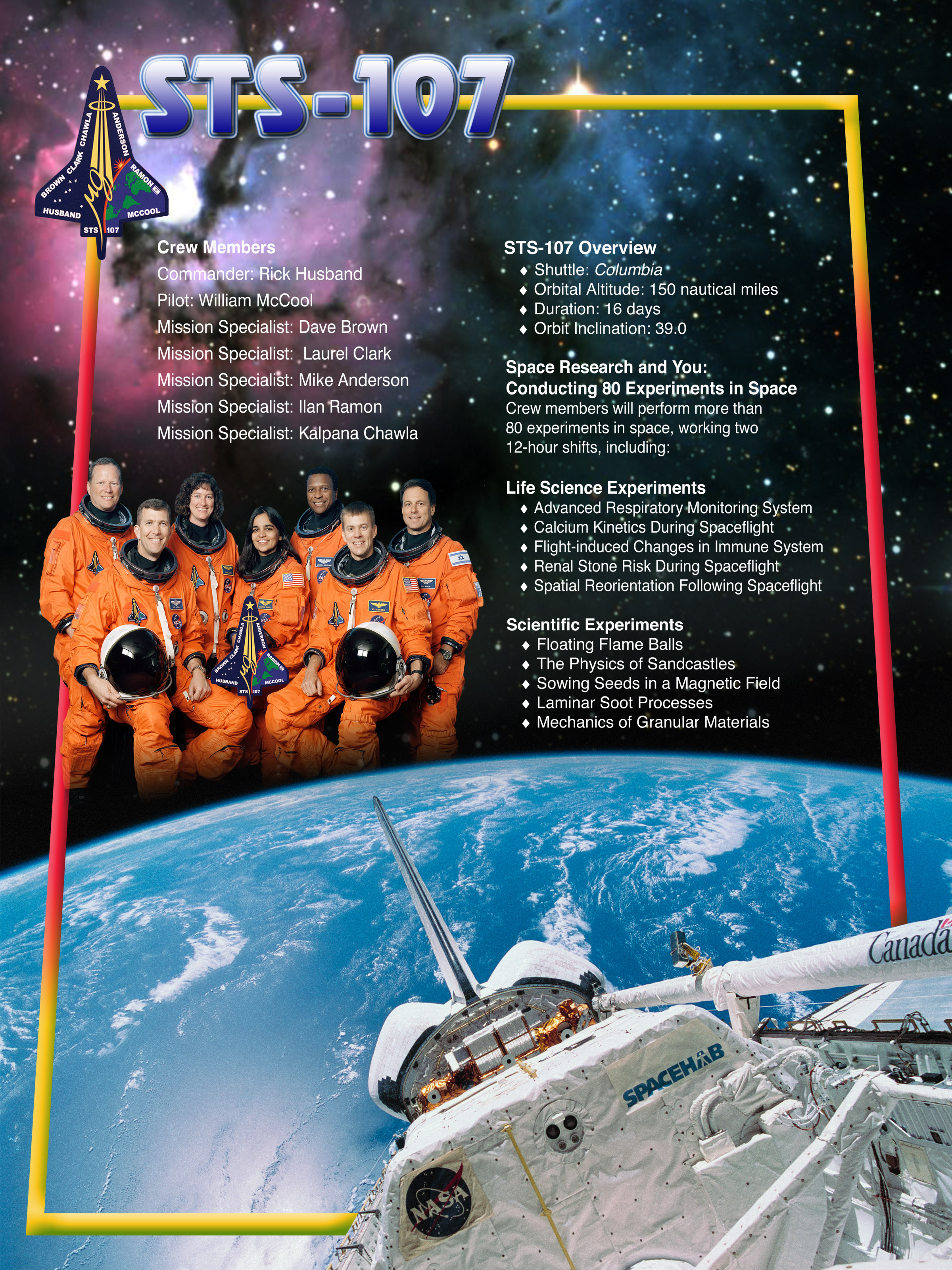

January 16, 2003 looked like a beautiful day for the launch of the Space Shuttle Columbia. The crew was a diverse group of people who had been preparing for years for this day. Everything looked good to go and NASA gave itself a premature pat on the back for another on-time launch. Some more cautious heads noted the foam that had fallen off the External Tank during launch, but their concerns were blown off. Foam had fallen off the External Tank before and many senior NASA officials believed that it would never cause a serious problem.
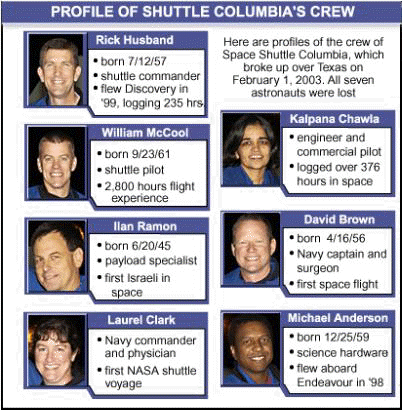
Rick Husband
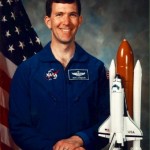 Mission Commander Rick Husband had previously flown as the Pilot of STS-96, the first Space Shuttle mission to actually dock with the International Space Station. During training for STS-107, he earned a reputation for being a capable leader.
Mission Commander Rick Husband had previously flown as the Pilot of STS-96, the first Space Shuttle mission to actually dock with the International Space Station. During training for STS-107, he earned a reputation for being a capable leader.
William McCool was the pilot of STS-107, known for his competitive nature that often extended into games like cribbage. When he wasn’t training for a mission, his Computer Science skills came in handy with upgrading the Space Shuttle Computers.
Ilan Ramon
 Ilan Ramon was selected from among Israel’s top military pilots to become that country’s first astronaut. His Personal Preference Kit (PPK) included items commemorating the Holocaust, some of which was lost, and a diary that survived the destruction of Columbia on its final mission.
Ilan Ramon was selected from among Israel’s top military pilots to become that country’s first astronaut. His Personal Preference Kit (PPK) included items commemorating the Holocaust, some of which was lost, and a diary that survived the destruction of Columbia on its final mission.
Laurel Clark
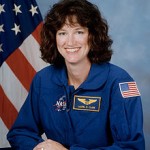 Laurel Clark was a Mission Specialist on STS-107 with a natural curiosity of the world around her and had been an Undersea Medical Officer in the Navy, working with rescue teams that assisted submarine crews in a crisis.
Laurel Clark was a Mission Specialist on STS-107 with a natural curiosity of the world around her and had been an Undersea Medical Officer in the Navy, working with rescue teams that assisted submarine crews in a crisis.
Kalpana Chawla
Kalpana Chawla was originally from India, a naturalized U.S. citizen and is often thought of as India’s first astronaut. She was the only civilian member of the STS-107 crew.
David Brown
David Brown was one of the few members of the Navy who was both a flight surgeon and an aviator. He enjoyed photography and videography and some of the footage he had taken of training for STS-107 made it into documentaries after the loss of Columbia.
Michael Anderson
Even as a kid in the 1960s, Michael Anderson never doubted for an instant that he would become an astronaut. In the Air Force, he flew Stratotankers and the T-38A and majored in Astronomy and Physics in college. On the STS-107 crew, he became known as the cautious one who didn’t like unnecessary risks.
Columbia’s Final Mission
For everybody but the astronauts, NASA personnel, and researchers involved, STS-107 looked like another boring research mission. Columbia wasn’t going to dock with the International Space Station, there were no planned EVAs, and they weren’t even going to use the robotic arm. The few points of interest included Ilan Ramon, who was Israel’s first astronaut and served as a payload specialist, and Kalpana Chawla, a Mission Specialist who had been born in India and naturalized in the United States. For sixteen days, the crew performed more than eighty experiments, found time for fun and Earth-gazing, and interacted with family members, government officials, students and researchers all over the world.
Only a few reporters actually covered the mission right up until February 1st. For all that STS-107 was ignored, the experiments would have led to practical results on Earth. MEIDEX was a study of dust movement in the Mediterranean meant to provide answers about how wind and wind-born particles moved throughout the Mediterranean region. Among other things, it could lead to a better understanding of how airborne viruses spread throughout a wide area. Biomedical experiments studied bone cells for a better study of the progress of osteoporosis, protein turnover in space, and the adaptation of the cardiovascular system in a microgravity environment. As astronauts had so often put it, “We are the experiment.”
Student experiments were included in a package known as STARS. They included a study of crystal growth in space, a look at how spiders spun their webs in space, an experiment involving the development of silkworms in space, and a study of how ants tunneled in space. Among other things, it taught students how science could produce surprising results and some of the students decided to continue their studies in honor of the lost STS-107 crew.
The crew also found time for some fun. During chats with their families, they took the opportunity to show off their microgravity environment. They tumbled, snatched chocolate out of midair with their mouths, and sometimes teased each other and people on the ground. Mission controllers could usually give as good as they got and one CapCom was heard to teach William McCool how to count to eight.
Meanwhile, some engineers were reviewing footage of the foam that had broken loose. It was difficult to tell what kind of damage it would have done to the Space Shuttle. Options for analyzing the problem were somewhat limited from their viewpoint. Too often, NASA management seemed more concerned with keeping to a schedule than the safety of the astronauts and could reject a perfectly sensible idea on the grounds that it would cause delays or become too costly.
Kalpana Chawla was one of the astronauts who realized what errant pieces of foam could do to the Space Shuttle. She had previously operated the robotic arm on STS-87 and observed that Columbia looked like it had gotten shot at afterwards. If she voiced any concerns about the problem, they either never reached the right people or they were not listened to. Mission controllers could have worked with her to use cameras on the robotic arm to inspect the damage.
The idea of an EVA to inspect the damage was also discussed. However, this idea was also vetoed on the grounds that none of the crew members were rated for EVA. The Columbia was not equipped for a rendezvous and docking with the International Space Station. After the tragedy, it was rumored that NASA had seriously considered sending another shuttle to rescue the crew, but decided not to risk it.
Long-standing questions included escape options for the crew. In early tests of the Space Shuttle, the pilot and commander positions had been equipped with ejection seats. Escape options for the entire crew had been discussed but never implemented, leading to former NASA employees blasting senior NASA officials for a purely political decision.
On February 1st, they were looking forward to landing when Kalpana Chawla alerted Mission Commander Rick Husband that the left aileron trim was approaching the operational limits. Vital heat-resistant tiles had been damaged by the flying foam and heat from the friction of reentry was causing damage to the wing. As the damage got worse, Husband and Pilot William McCool fought to maintain control. Mission Control noticed the problem and tried to keep the crew updated, but lost contact just as Husband was acknowledging. Sixteen minutes before the scheduled landing, streaks of light were filmed in the sky. The Columbia and its crew were gone.
A variety of factors, many of them human, had come together to cause the destruction of the first Space Shuttle to fly in space. The report put together by the Columbia Accident Investigation Board was scathing of NASA management and departments closely involved in the space shuttle, especially those who didn’t listen to concerns about flying foam that had repeatedly caused damage to space shuttles. Recovered components of the Columbia are now on display as a cautionary tale of the hazards associated with space exploration.
The remaining shuttles were promptly grounded indefinitely. An investigation was organized within two hours of the disaster. President Bush was informed and made his way from Camp David to Washington, DC to address the nation. Local police forces quickly organized searches for debris and human remains. The Internet was watched for attempts to sell debris over the Internet which could be valuable evidence in the investigation.
Space Shuttle Collectibles on eBay
[ebayfeedsforwordpress feed=”http://rest.ebay.com/epn/v1/find/item.rss?keyword=Space+Shuttle+STS-107&categoryId1=1&categoryId2=267&sortOrder=BestMatch&programid=1&campaignid=5337337555&toolid=10039&listingType1=All&lgeo=1&feedType=rss” items=”10″]



